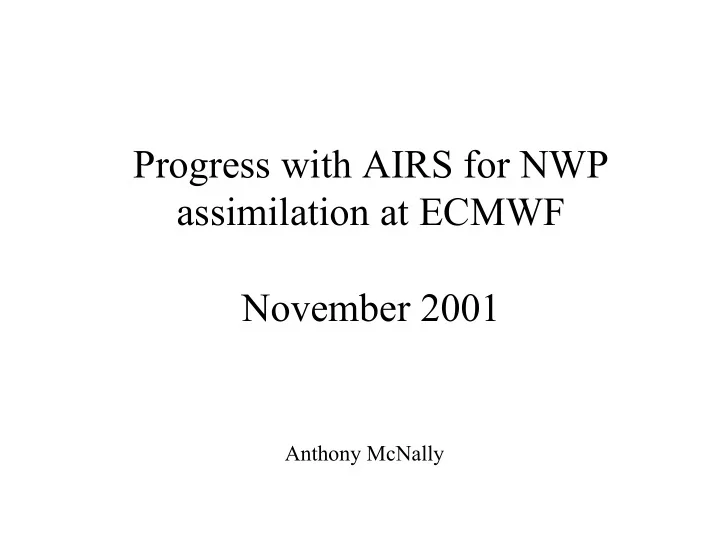

Progress with AIRS for NWP assimilation at ECMWF November 2001 Anthony McNally
Technical status / plans • NESDIS/NRT BUFR data in to OBB (via OBSPROC) • RTTOV(M) installed in IFS to process AIRS • Level-1C assimilation elements extended to AIRS • end-to-end 3D/4D Var testing complete • New AIRS/IASI monitoring tools developed • Ingest AIRS BUFR with PREODB • Investigate timings for monitoring / assimilation
Scientific status / plans • RTTOV(M) compared to NESDIS / UMBC AIRS RT • Limited evaluation of EOF data compression • Vertical structure functions v sensitivity correlations • Cloud correlation with sensitive areas established • day-1 detection of clear channels in progress • Investigate recovery of key features with clear channels • Review day-1 channel selection in light of cloud detection
Cloud detection by pattern recognition The difference between observed cloudy radiances and clear-sky radiances computed from a NWP first-guess is a superposition of 3 distinct components •First-guess (forecast) error mapped in to radiance space (HBH T ) •Radiometric (instrument) and RT model error (O+F) •The cloud radiance signal (clear minus cloudy) (Rclr-Rcld) HBHT (fg error) [O+F] (RT/obs error) dTbcld (cloud signal) Ranked channel index Ranked channel index
What do we know about the forecast error signal ? • We have models of T/Q/O3 error that can be mapped in to radiance space HB(T)H T •We have routine statistics from our operational monitoring of AMSUA and HIRS clear data HB(Q)H T • The longwave part of the spectrum is the most difficult due to the correlation of HB(O3)H T T/Q/O3 errors.
What do we know about the instrument/RT error signal ? • We know the instrument noise - it should be uncorrelated unless calibration errors are important • We know fast model error is small and correlated in a known way between channels • We are not sure about LBL model error/ instrument spectral characterization
What do we know about the cloud signal ? • Over warm surfaces (non-frozen) it is always negative •In band split / ranked channels it increases monotonically negative •We can identify an “obviously” contaminated channel and step backwards with a digital filter to locate the first channel with discernable cloud contamination •All channels ranked as higher peaking can safely be assimilated as Clear channels Cloudy channels clear
AIRS Channel ranking – Channel dBTs: ranked - detection by filter
What does the digital filter do? From our statistical knowledge of a) radiometric noise covariance b) forecast radiance error covariance (T/Q/O3) We create a filter to separate the above from the cloud radiance signal. Two different filters have been tested so far a) Empirically tuned “low-pass” filter b) Objective Chi-squared filter using explicit forecast error covariances
AIRS Cloud detection – Filter detection: index of lowest cloud-free channel
Recommend
More recommend